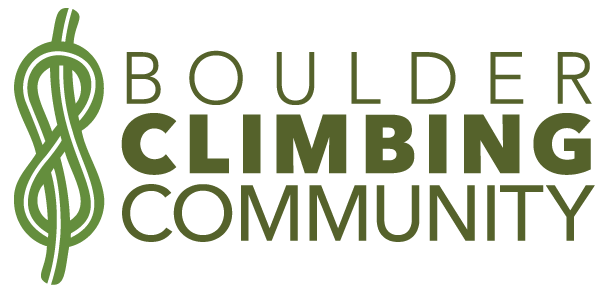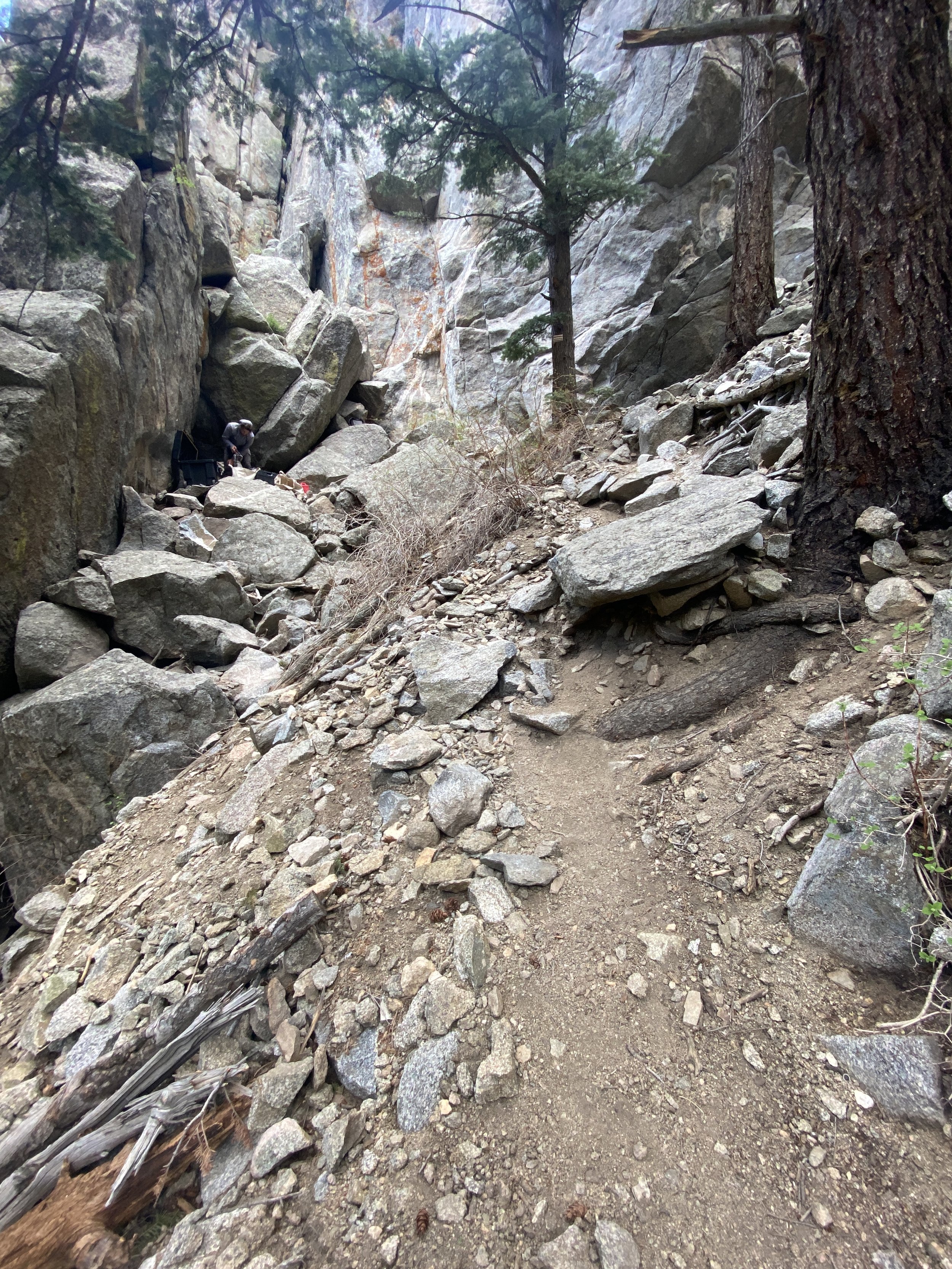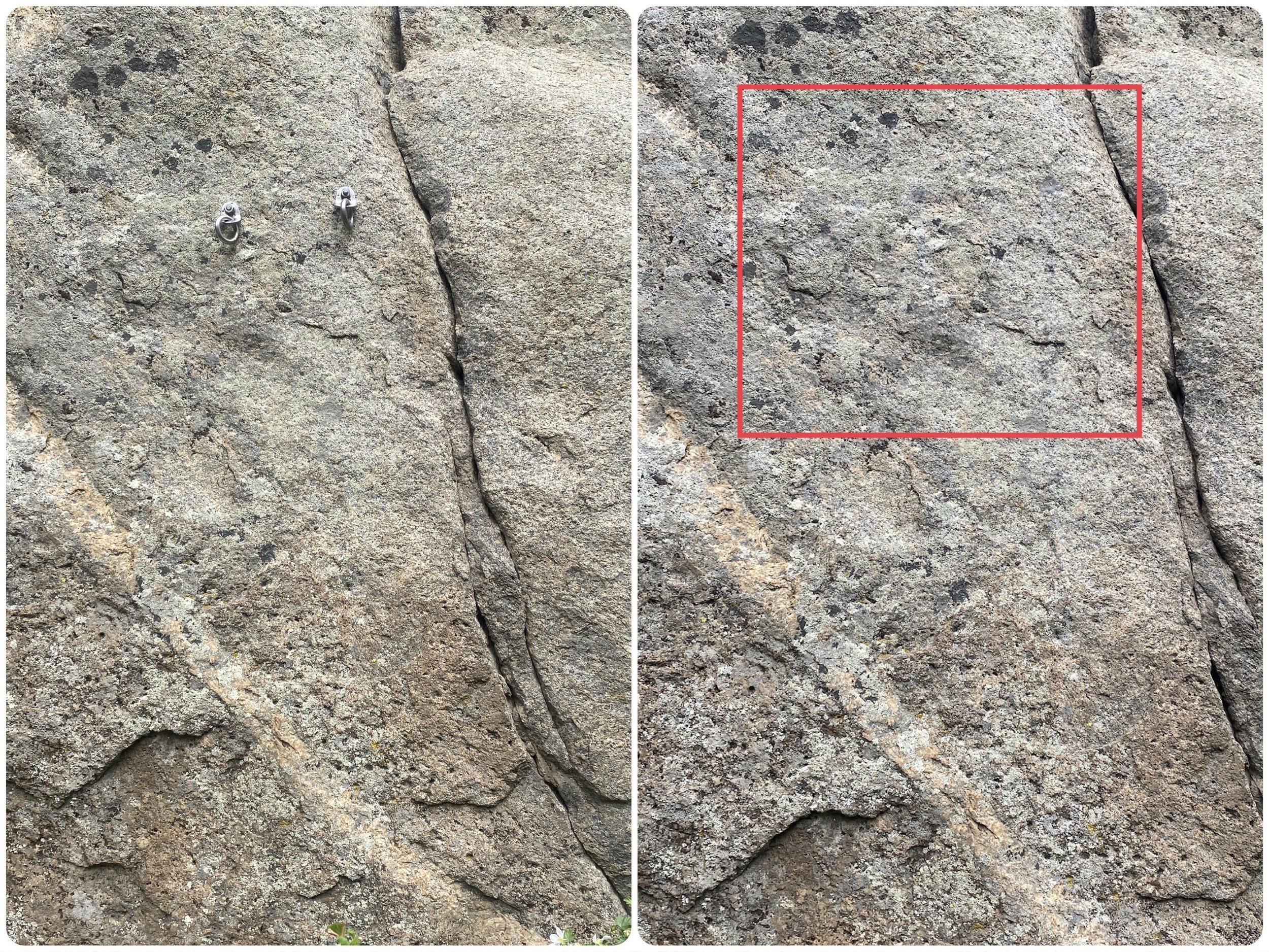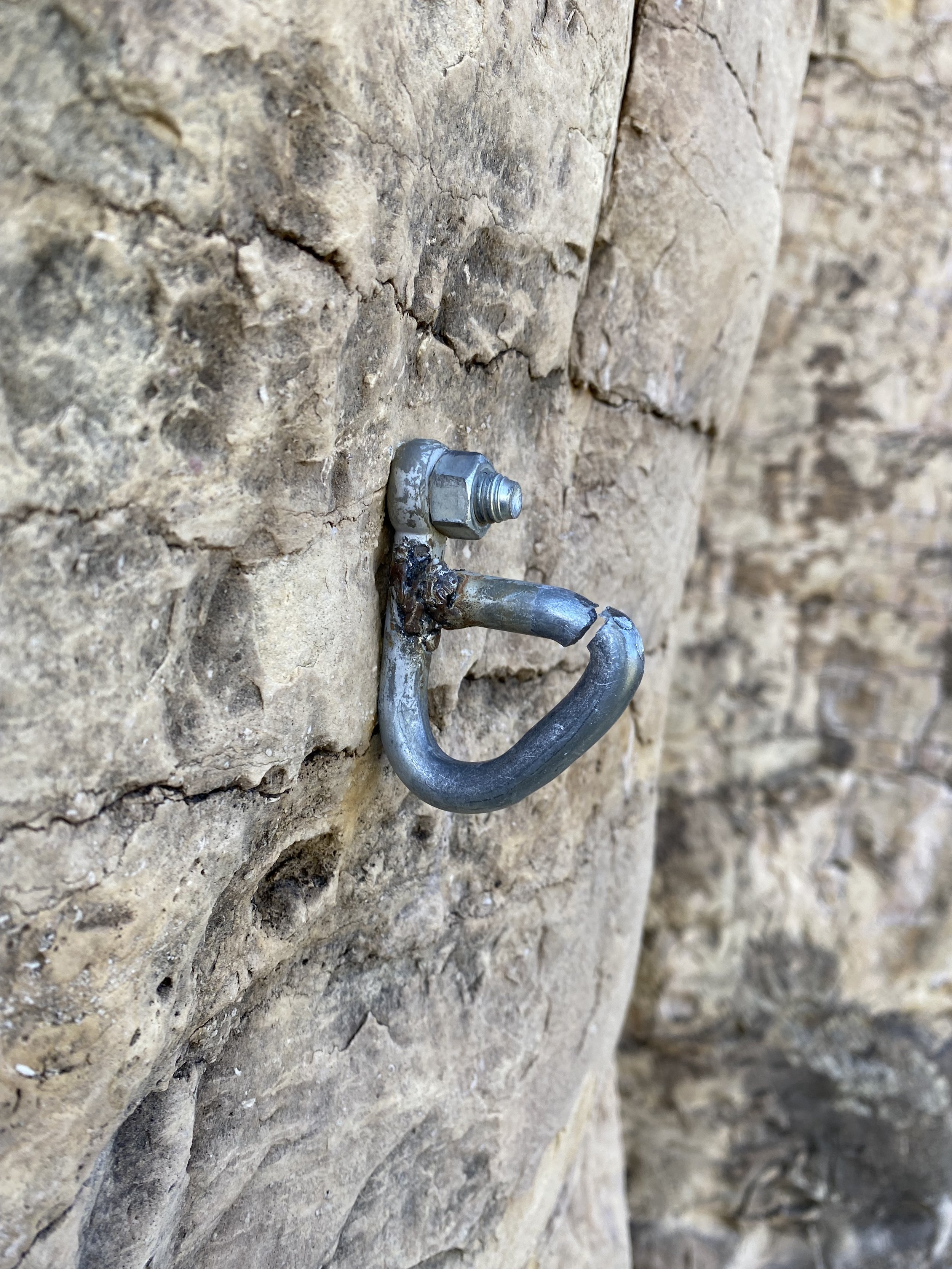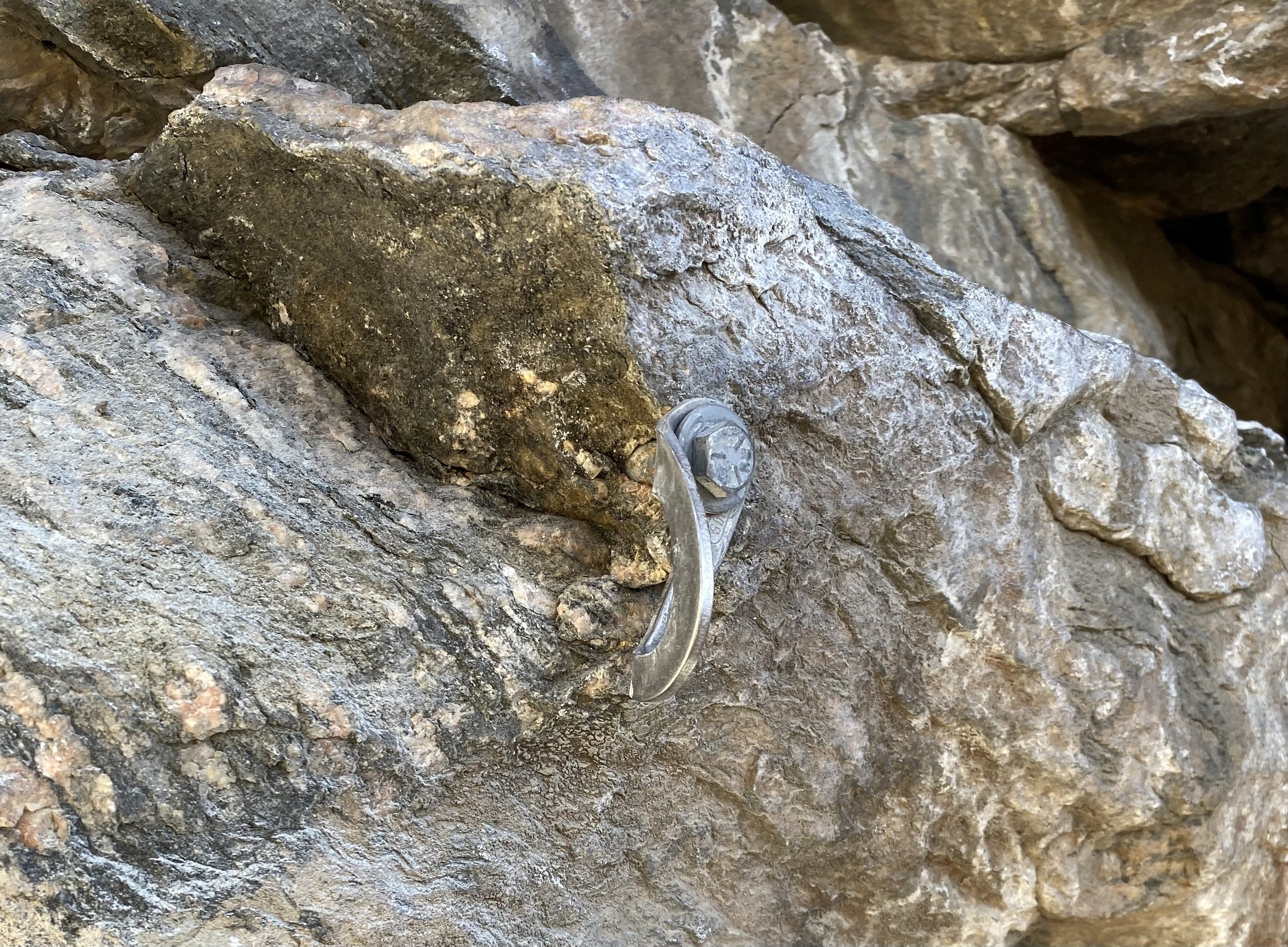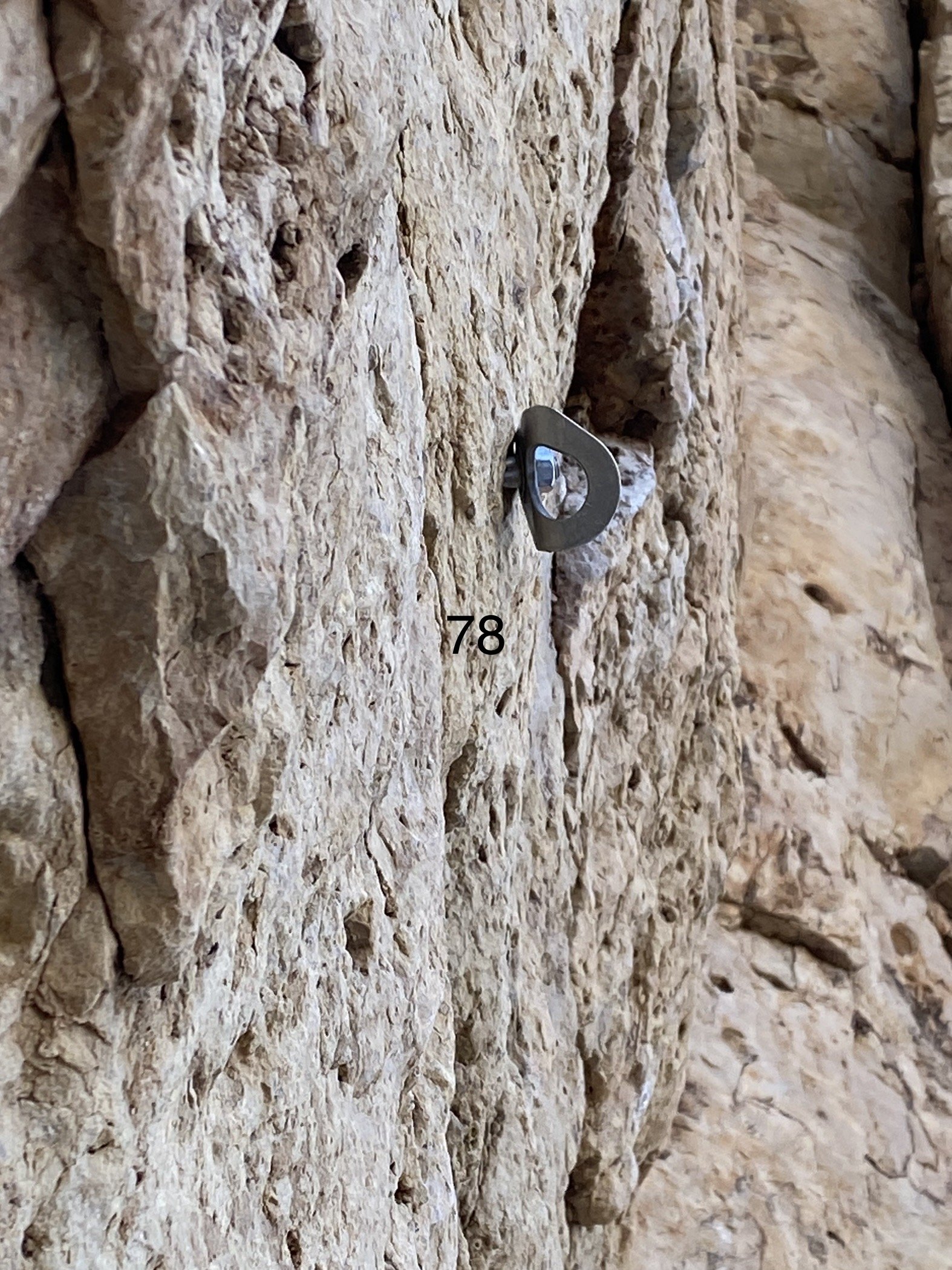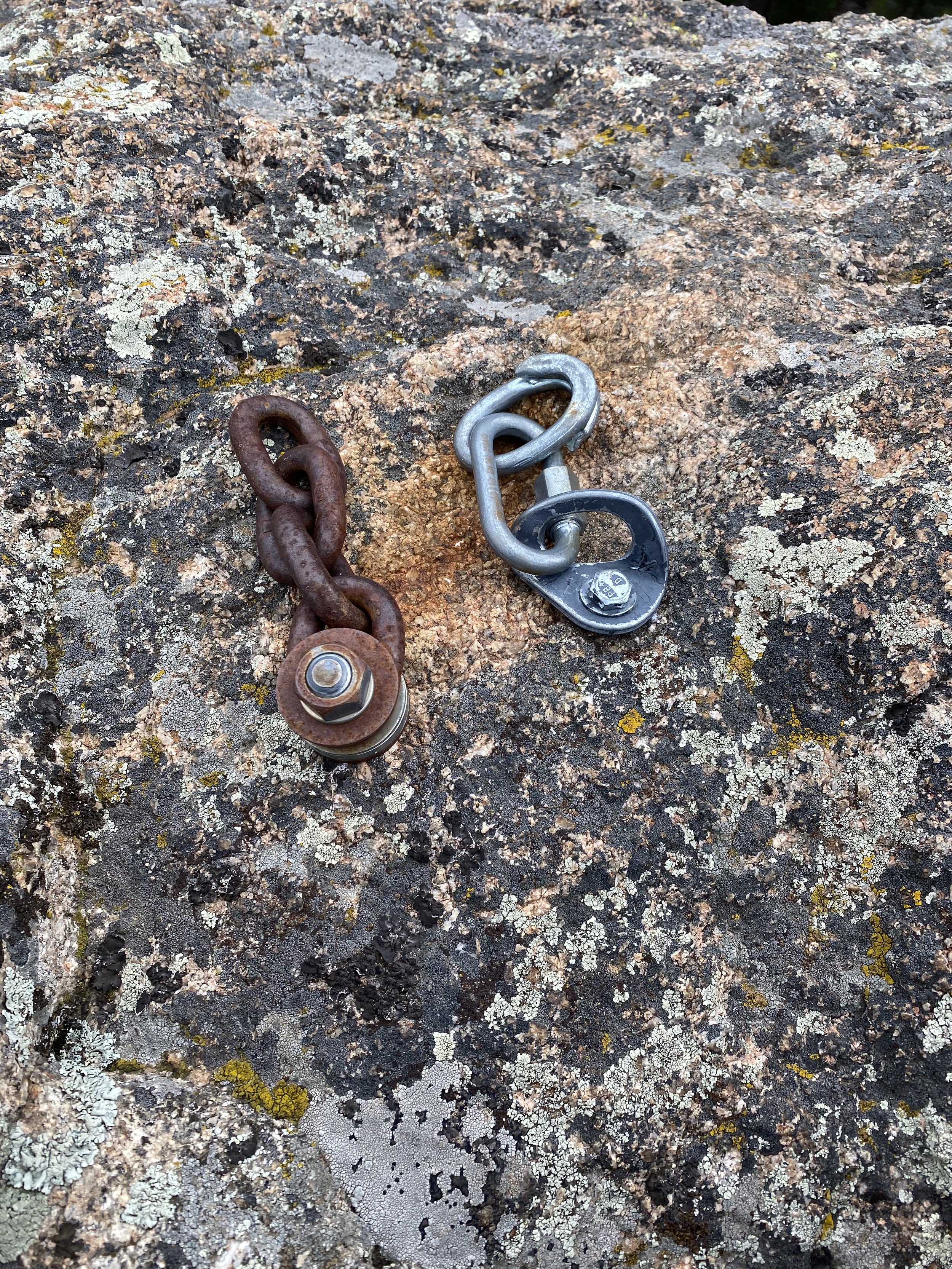The 2024 stewardship season is here! We’ve got a busy schedule of trail building, bolt replacement, raptor monitoring, events, and more!
2023 End of Year Wrap-Up: Eagles, Trails, Community, and more!
Our 2023 Stewardship Season came to an end just before Thanksgiving, the Trail Program finished up the Lower Tiers of Zion project, and the Anchor Replacement Program hosted its last crag rebolting event of the year at North Table Mountain. It's been a big year for BCC and our community! In 2023, we had over 1,100 volunteers and over 7,000 volunteer hours, that's almost $190,000 in volunteer contribution to taking care of our climbing areas!
BCC Trail Crew and volunteers hard at work on the Saddle Rock Trail.
Trails
Our staff and community have been a part of some amazing projects this year.
Over 360 volunteers helped our Trail Program with our four projects this year.
BCC finished the Avalon trail project by shifting the trail into the talus field to create a durable trail.
Reconstructed the approach to Dome Rock and Elephant Buttress.
Began a multi-year project rerouting the Saddle Rock trail behind the First Flatiron.
Gave Lower Tiers of Zion a huge makeover with over 300 square feet of retaining wall built to provide a durable trail and belay pads.
BCC was awarded the Blue Grama Award for Outstanding Achievement in Recreation Management for our work on the Castle Rock Overlook project in Boulder Canyon.
An estimated 1,700 people use this trail each month during the summer months
Anchor Replacement Program
Two Amazing BCC Volunteers, Elizabeth Flournoy and Taylor, replacing one of 1,000 bolts in 2023.
288 volunteers replaced over 1,000 bolts (and counting)
339 in Clear Creek Canyon
232 in Boulder Canyon
144 at Shelf Road
170 at North Table Mountain
21 in the Estes Park Valley
10 at Mount Lincoln
12 in the South Platte
3 in Staunton State Park
2 in the Flatirons
Trained over 90 new rebolters via our Anchor Replacement Training
This included the BCC hosting two affinity groups, Latino Outdoors and She Sends Collective
One of 1,000 Bolts Replaced in 2023
Over 280 trained volunteers worked to replace these bolts. This one was replaced at Wall of the 90s.
Other Programs
One eagle was fledged at Eagle Rock and there were no infractions in the seasonal closure areas
Over 2,000 wag bags have been distributed to wag bag dispensers and climbing gyms to keep our climbing areas clean.
Advocacy
On the advocacy front, the BCC supported some excellent national and local policies to further the interests of all climbers:
Protect America’s Climbing Act (PARC and America’s Outdoor Recreation Act (AORA), the BCC partners with, and supports, Access Fund’s work on the PARC Act–the BCC actively engaged with our local members of Congress to garner support for PARC; and effectively protect existing use of fixed anchors in wilderness. The PARC Act is currently under consideration by the House of Representatives.
The BCC in 2023 supported the creation of Fix-CRUS to advocate for important changes to the Colorado Recreation Statue.
BCC raptor monitoring volunteers worked tirelessly and ensured closures were lifted sooner at Lumpy Ridge in Rocky Mountain National Park.
BCC staff have worked with local land managers to put into place policies for easy bolt replacement at all local crags.
BCC advocated with public and private land managers to preserve or improve access in Rocky Mountain National Park, Wild Basin, Button Rock Preserve, St. Vrain area, Boulder Canyon, Flagstaff, the Flatirons, and Clear Creek Canyon.
Our Vision: The Best Cared for Crags in the Country
Armed with a new strategic plan, the BCC set out in 2023 to level-up on caring for local crags by:
Increase bolt replacement by 60%: from 500 to 1,000 bolts
Ensure a path to pooping within 20 minutes of every crag: help people understand where to poop in any circumstance
Increase trail work capacity by 50%
Earn BCC the reputation as the go-to organization for Front Range Climbing
Replace 75% of aging bolts in Boulder Canyon within 5-years
Increase trail volunteers by 20%
Here is what we have achieved so far this year:
Trails Program:
It's been another year of big projects for our trail crew. We began the season at Dome Rock in Boulder Canyon, replacing the rotting wooden structure that access the Dome and Elephant Buttress with an updated stone structure that will be around for decades to come.
Once Dome Rock was completed, we began our final trail work session at Avalon. After 20 weeks of work over the last three years, BCC completed the Avalon project! We started work at Avalon to address the major erosion issues occurring at the Middle Wall area as well as on the approach. Our trail crew tackled the trail and base area of the Middle Wall first, building a durable trail through a talus field and constructing retaining walls and belay pads in order to prevent erosion. This year, we began constructing an easier path to follow through the major talus field that sits to the left of where climbers typically hike up towards the Middle Wall. This involved a lot of rigging and manipulation of fridge size boulders in order to stabilize the talus field. With the new approach trail, climbers will be able to access the Middle Wall, Tarot Wall and all the other areas above Avalon via a durable trail that will prevent erosion of the hillside.
The trail crew has a few more weeks of work behind the First Flatiron on the Saddle Rock trail before heading to the increasingly popular Lower Tiers of Zion in Clear Creek, where we will be working for 3 months, giving the area a major overhaul.
Anchor Replacement Program:
The BCC is well on its way to reaching its goal of replacing 1,000 aging fixed anchors, to date we have upgraded 760 fixed anchors throughout the Front Range and volunteers have contributed 1,500 volunteer hours rebolting. BCC has hosted entire crag rebolting days at
Contest Wall, Shelf Road
Little Eiger, Clear Creek Canyon
Black Widow Slab, Boulder Canyon
Sport Park, Boulder Canyon
BCC has been expanding our anchor replacement training program in order to mentor new rebolters and have hosted training and rebolting days with members from She Sends Collective, Latino Outdoors, and Escaladores Unidos.
In addition to all the on the ground work, BCC has been involved in helping protect wilderness climbing with the American Outdoor Recreation Act and Protect America’s Rock Climbing. The BCC supported legislation introduced by our Boulder House and State Representatives, Joe Neguse and John Hickenlooper that would guarantee the continued use of fixed-anchors as climbers have always had. This legislation could be passed as soon as September; stay tuned.
Human Waste:
BCC continues to provide wag bags to climbers in order to keep our climbing areas free of human waste! So far this year, almost 700 wag bags have found their way to dispensers throughout the Front Range thanks to our awesome group of volunteer restockers.
Raptor Monitoring
In January, BCC staff and volunteers met with the staff of Rocky Mountain National Park to seek changes to to the blanket closures on Lumpy Ridge. The work of a handful of amazing volunteers and the RMNP staff resulted in several closures being lifted early due to no nesting.
BCC staff also hosted a raptor monitoring training for Boulder Canyon and recruited ten new volunteers who spent 6 months monitoring all the Golden Eagle nesting sites in Boulder Canyon. Due to their efforts, Blob Rock and Bitty Buttress were open early for climbing while Eagle Rock remained closed due to a Golden Eagle pair using it as their nesting site. That pair had one chick successfully fledge and leave the nest and Eagle Rock was reopened for climbing shortly after. To learn more about this years raptor monitoring efforts, check out our recent blog post.
Advocacy:
In January BCC staff and volunteers lobbied for legislation that would reform Colorado’s Recreation Statue to guarantee more safeguards for land owners who allow recreation on their property.
Seasonal Raptor Closures are Being Lifted Early
Each year, the Boulder Climbing Community partners with the US Forest Service, Rocky Mountain National Park, and City of Boulder Open Space and Mountain Parks to help monitor nesting raptor species and get the word out about seasonal closures at popular climbing areas. Via raptor monitoring, the climbing community has been able to build trust and connections with land management agencies that have helped preserve and improve climbing along the Front Range.
Did you know that climbers have been involved in raptor monitoring in Boulder Canyon since 1983. During that time climbers have documented 29 Golden Eagles fledged in the canyon!
Land management agencies have dual obligations to preserve natural resources and promote recreational opportunities. A crag closure process that balances the needs of cliff-nesting raptors and the wants of climbers is ideal, but balancing these competing goals is resource intensive. When resources are limited, a precautionary strategy for resource managers is to have more extensive (in space and time), conservative closures. Conservative closures could be larger or last longer than necessary, but nonetheless provide raptors with the protection needed for successful reproduction. Over the past years, the Boulder Climbing Community, Access Fund, US Forest Service Boulder Ranger District, City of Boulder OSMP and Rocky Mountain National Park have been working together to find ways to allocate more resources toward raptor and climbing management to make closures as effective (for raptors) and efficient (for climbers) as possible.
In 2023, that has resulted in:
1. Climbing areas in Boulder Canyon, RMNP, and the Flatirons being reopened early for climbing. Check out our closure page for up do date closures and see what areas have reopened for climbing.
2. Successful fledging of one Golden Eagle chick at Eagle Rock.
3. RMNP has hired a seasonal wildlife biologist dedicated to bird biology, with a large share of time allotted to raptor management.
4. The community has provided a dozen volunteer observers, some of whom are local climbers, who go out several times a week during the breeding season to determine active territories and nest fates.
5. RMNP has provided climbing rangers who work with the wildlife biologist and volunteer observers to conduct test climbs that confirm observer reports that raptors are not nesting on crags. In 2023, the climbing rangers put more than 100 person hours towards those efforts.
6. The community has provided volunteer climbers who, along with climbing rangers, conduct post-season nest visits to determine specific nest locations and glean more details about nest fate. In 2022, volunteers put approximately 300 person hours towards observation and nest visit efforts.
Thanks to everyone at the the various land management agencies and in the community for contributing to this win-win effort!
Fixed Anchors and Climbing in Wilderness: What do climbers need to know?
Respecting Rules and Regulations Regarding Fixed Hardware
The BCC would like to encourage our community to keep multiple topics in mind when placing new hardware in the Front Range. This includes working with landowners to ensure permission, keeping in mind the local ethics of our crags and fostering positive gains from new development and fixed hardware
When installing fixed hardware at climbing areas it is critical to know the rules and regulations for the land manager where the climbing area resides.
This past week, a two bolt anchor was installed at Castle Rock in Boulder Canyon next to the route “Gill Crack”. The placement of this anchor was such that it would only be suitable for ground school learning. Castle Rock is located on Boulder County Parks and Open Space (BCPOS) land and the fixed hardware was placed without the land manager's approval. Furthermore, BCPOS currently has a moratorium on new fixed hardware being installed on climbing areas within their land. As a result, the fixed hardware was removed and the drill holes patched.
By installing fixed hardware and ignoring land management regulations, individuals are negatively impacting the strong relationships the climbing community has built with various land managers along the Front Range.
While ground school anchors are an excellent option for teaching and learning, installing bolts at established crags is not the appropriate method. A few areas that have already been established to aid in learning climbing skills are the Classroom at Staunton State Park, The North Quarry at North Table Mountain and the multi pitch route “Trenchtown” at Lower Tiers of Zion. Another readily available option are practice boards which can be placed using traditional anchors or slung around a tree and can be removed at the end of the day.
The BCC’s Anchor Replacement Program is the leading organization for ethical bolt replacement, and the local stewardship organization for the Front Range. Learn more and get involved by visiting BCC’s website.
Questions can be directed to BCC’s Stewardship Director, Ryan Kuehn ryankuehn@boulderclimbers.org
Stewardship Season is Here!
The Boulder Climbing Community wants climbers along the Front Range to have the best cared for crags in the country!
What does it mean to have the best cared for climbing areas in the country? And how do we accomplish that as an organization? It all starts with our stewardship efforts. BCC staff has put a lot of work during this cold and snowy winter to make sure that we hit the ground running once the sun comes out and it becomes t-shirt weather again.
Trail Program
BCC’s Trail Program is entering its 10th season of working on improving our Front Range climbing areas. Over the last decade, we have established positive relationships with various land managers to make us the go-to organization for climbing area related trail work and are excited to have some amazing projects for 2023. This year, BCC will be working at the following areas:
Dome Rock, Boulder Canyon
Avalon, Boulder Canyon
Saddle Rock, Flatirons
Lower Tiers of Zion, Clear Creek Canyon
Our Trail Program is offering lots of ways to get involved, with 16 weekend volunteer and opportunities as well as over 100 weekday volunteer trail days. If you or your organization wants to come out for a trail day, check out our Volunteer Calendar.
Anchor Replacement Program
BCC’s Anchor Replacement Program (ARP) went above and beyond in 2022 replacing 906 aging bolts! We were able to accomplish this due to our awesome community of volunteer rebolters. For 2023, we aim to replace 1,000 bolts all along the Front Range. This will be a lot of work so we are working on teaching new volunteers to become BCC rebolters via our 3-Part Anchor Replacement Clinics. BCC will also be hosting monthly crag rebolting events at popular climbing areas such as:
Contest Wall, Shelf Road
Little Eiger, Clear Creek Canyon
Plotinus Wall, Boulder Canyon
Jurassic Park, Estes Park
And more!
If you are interested in becoming a rebolting volunteer click HERE
Raptor Monitoring
Climbers have been instrumental in the success of Golden Eagle nesting in Boulder Canyon and we want to continue to grow this program by training new volunteers to become Raptor Monitoring volunteers. Via BCC’s monitoring and documentation, Blob Rock, Bitty Buttress and Security Risk have all opened early for climbing.
BCC is also getting involved with Raptor Monitoring in Rocky Mountain National Park, working with NPS staff to monitor nests at Lumpy Ridge.
Human Waste
BCC will continue to provide wag bags to climbers via wag bag stations in the Flatirons and Clear Creek Canyon, and gym kiosks at Front Range climbing gyms. BCC is also looking into alternatives at popular climbing areas such as port-o-potties or composting toilets in order to make sure that wherever you are climbing in the Front Range, you will have access to a restroom option within 20 minutes.
Advocacy Program
The BCC’s Advocacy Program is our newest program and is quickly becoming one of the best ways BCC works to protect and improve climbing in the Front Range and beyond. In 2022, the Advocacy Program spent 725 hours on initiatives to maintain and bolster Front Range Climbing Areas. You can reach our advocacy team, via our Executive Director, Kate Beezley.
Here is some of what the BCC will be keeping tabs on on behalf of Front Range climbers in 2023:
Clear Creek Canyon:
The BCC team is working with the Frei Family in Clear Creek Canyon, west of Tunnel 5, to secure climbing access long term. (Includes local treasures like the Primo Wall and the Dog House.)
United States Forest Service:
Currently monitoring the St. Vrain Forest Health Project to assure climbing north of Boulder will not be affected by Forest Health projects.
Monitoring and actively commenting on what is happening in the NPS (see below) because the NPS will drive the direction of USFS land management.
Boulder County Open Space:
The BCC continues to have a positive working relationship with them and is seeking out opportunities to partner more closely in the future.
National Park Service:
RMNP- our backyard national park.
The BCC continues to work with the park to build a more robust and flexible raptor monitoring system, especially to get closures lifted if nesting has not occurred.
Monitoring reservation and parking policies to ensure climbers have a voice.
Bolts in Wilderness-the BCC is actively weighing in on management plans, to date the Black Canyon and Joshua Tree National Park, to ensure the spirit of recreation in the Wilderness Act is maintained. (Learn more about Access Fund’s work on this below)
Protect America’s Climbing Act (PARC)- The BCC partners with, and supports, Access Fund’s work on the PARC Act–the BCC actively engages with our local members of Congress to garner support for PARC.
There is a good summary of PARC in a recent episode of the Runout Podcast.
City of Boulder Open Space and Mountain Parks:
Flagstaff Parking Permits: BCC is working with the city to find a solution to the nighttime parking closures on Flagstaff so climbers can continue to use the resource in the late evenings.
State of Colorado:
Eldorado Canyon State Park-reminder that permits are needed to park on weekends and holidays starting May 15th.
Colorado Recreation Statue (CRUS)- In March the BCC went to the state Senate Judiciary Committee to testify on behalf of the Front Range and Colorado climbing communities on a bill to change language in the CRUS to increase protection for land owners who let us recreate on their lands, it died in the committee but the BCC is supporting a coalition focused on reforming CRUS over the next 18 months.
Jefferson County:
Monitoring the plans for the Plains to Peak Trail, to minimize any effect on climbing.
Closely following parking developments at North Table Mountain to assure that resident complaints do not result in any loss of access.
We hope you all are as excited about the work the Boulder Climbing Community will be doing this year as we are! If you want to get involved, consider volunteering, becoming a member, or donating to our fundraising campaign.
Sustaining the Momentum: 2022 End of Year Report
“The flywheel, when properly conceived and executed, creates both continuity and change. On the one hand, you need to stay with a flywheel long enough to get its full compounding effect. On the other hand, to keep the flywheel spinning, you need to continually renew, and improve each and every component.” Jim Collins, Turning the Flywheel.
Building off of the momentum of previous years, the BCC continued to turn the flywheel in 2022. The BCC continued their stewardship work: multi-year trail projects, human waste mitigation, and eagle monitoring. While these core components of the organization continued to thrive the BCC took on new directions and initiative in the Anchor Replacement and Advocacy programs.
A 5-Year Strategic Plan was developed to continue to evolve, refine, and optimize every program to ensure the BCC continues to provide the most well cared for climbing areas in the nation.
The BCC had an incredible year for trail stewardship, bolt replacement, and local climber advocacy. You can read about all of the accomplishments in the 2022 End of Year Report.
If you are psyched on what we do, we would love you to support us monthly by becoming a sustaining member.
We hope you’ll join us at Neptune Mountaineering on April 6th from 7-9 PM for an opportunity to learn more about what the BCC has planned for the future, have your voice heard on key initiatives, and connect with other members of the community. Get your tickets here.
BCC Advocacy: Protecting Access to Local Climbing By Supporting Land Owners (SB-23-103)
The BCC supported State Bill 103: read about what this Bill hoped to accomplish, why it mattered to climbers.
As climbers are aware, climbing happens on both public and private land, so protecting landowners from lawsuits is important for the BCC to support.
Unfortunately, the Bill did not move forward from the Judiciary Committee; access to 14ers, Lincoln and Democrat, was immediately lost.
Assessing Bad Hardware While Climbing; the Do’s
Ever clip a bolt, move past it, and then wonder if it will really hold if you blow that next move? Playing it safe doesn’t hurt, and bolts shouldn’t be blindly trusted, but thankfully, even most of the spinners and crusty bolts are still strong. Most rusty bolts BCC replaces are still safe, and are replaced before rusting prevents removal, rather than because they are about to fail. That said, here are some suggestions on what to do if you spot a bad bolt, and some things to look out for.
The best ways to support replacement of old, bad, and unsafe hardware in the front range is donating to BCC’s Anchor Replacement Program (ARP), becoming a member, and volunteering with the ARP. We’ll even teach you the skills to be a rebolter! In addition, you can report bad and questionable bolts to BCC and one of our volunteers will get out to check it. Including pictures is always helpful.
Spinners: These are the most common “bad bolt” but thankfully tend to be more inconvenience than safety hazard. They can usually be remedied by gently snugging down the nut or bolt head either by hand, or with a short wrench. Snug is good enough if you don’t have a torque wrench or know the proper tightness.
Rust: As mentioned above, rust does not automatically indicate an unsafe bolt, especially if just on the metals surface. However, it is difficult to know if the bolt has been compromised, and they should be reported and replaced.
Homemade hangers and shuts: While many of these have been replaced, there are still routes with old or home-made hardware, such as cold shuts, or angle-iron “bedframe” hangers. Many of these are quite strong, but with inconsistent quality when new, and now being quite old, this hardware should be reported and replaced.
Homemade angle iron
Cold Shut.
Bolts near edges and fractures: These bolts deserve some skepticism even if newer. Over time, the outward pressure mechanical bolts exert can fracture the rock, as seen in this picture from Clear Creek. This bolt was near failure when replaced and was removed by hand without special tools.
Overly protruding bolts: These should also be reported and used with skepticism. This is often a sign of poor placement, inappropriate bolt type, or erosion of the hole. They likely do not have sufficient embedment, and may create a levering action on the bolt. This bolt from the South Platte was loose in its hole, and only about 1.5” into the rock. This newer bolt in Shelf Road was poorly placed and creates a levering action on the bolt shaft.
South Platte
Shelf Road
Buttonheads, Star Drive, and other old bolts: These are now quite rare, but may be encountered in backcountry areas, and less frequented crags. Any button head or start drive should be used with caution.
Button head
Star Drive
Power-Bolt+: These newer bolts were unfortunately inadequate from the time they were first installed. Introduced as a replacement to the very common 5-piece bolts (power bolt, sleeve bolt), the 3/8” version of these only has a 1/4” core and does not meet modern standards. These bolts appeared at several crags in the last several years and should be reported to be replaced. These are easy to identify as the head is stamped PB+. The larger 1/2" versions will need to be replaced eventually as they rust but are safe in the near term.
RMNP Visitor Use Management Strategy
Don't Let Hip Pain Stop You From Climbing!
BCC Awardees 2022
Each year the BCC awards outstanding members from our community at our annual Soirée. This year we presented awards to Alex Mandrila (The Steward), Michael Gapuz (The Steward), Kevin Capps (The Pioneer), Aubrey Runyon (The Partner), and Mike & AnneWorley Moelter (The Champion).
Read stories and interviews below for all of our Awardees!
Wrapping up 2022
In the climbing community we talk a lot about ethics and crag behaviors. The goal is to maintain climbing access by making climber behaviors align with sustainable recreational use practices. At the BCC we have keenly observed that the best way to change behaviors is through our volunteer program. When BCC staff teach folks WHY.
The Science of the Chicken Wing
Article by Dr. Evan Ingerson of Mend Physical Therapy, Supporting Sponsor of the BCC
“Chicken-winging” is a movement that every climber experiences. It is defined as a pattern of movement where the elbows raise to the sides instead of being tucked down closer to the chest. This compensation shows up when we’re fatigued and climbing near our limit. We all get told to avoid this position but many of us do not understand why it happens and if it’s truly bad for you.
How to Safely Return to Climbing After Injury or Time Away
Article by Dr. Evan Ingerson, DPT of Mend Physical Therapy, Supporting sponsor of the BCC
Returning to rock climbing after an injury or an extended break from the sport can be challenging. Many climbers do too much too quickly and end up re-aggravating their previous injury or causing a new one. While it may seem obvious to “go slow” and return to climbing “gradually”, there is little to no guidance as to the specifics for an appropriate return-to-climbing protocol.
BCC's 5th Annual Soirée
Tickets are on sale now for our annual Soirée held on Thursday, November 3rd at Rembrandt in Boulder. Come join us for an evening of celebration, connection, and revelry as we raise funds for crucial Front Range climbing stewardship projects. Secure your tickets here!
The Pelvic Floor: The Frequently Overlooked Limiter of Climbing Performance
Let's Celebrate: 671 Bolts and Finished Trail at Upper Dream
Are Your Hips Causing Your Shoulder Pain?
Article by Dr. Evan Ingerson, DPT of Mend Physical Therapy, Supporting sponsor of the BCC
It may not seem obvious, but weakness in our hips can lead directly to shoulder pain while climbing. Because climbing requires the use of all extremities simultaneously, impairments in one region of the body almost always have a direct impact on the other extremities. One of the most common, but seldom recognized, patterns is the relationship between the shoulder and the opposite side hip.
